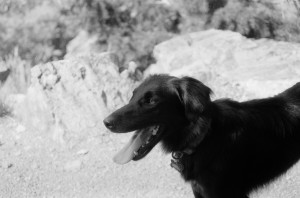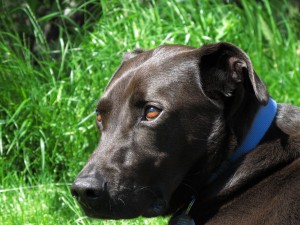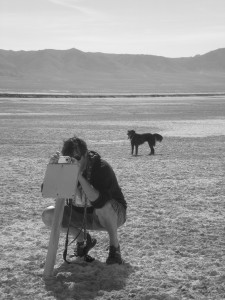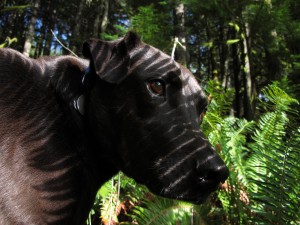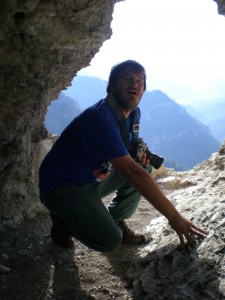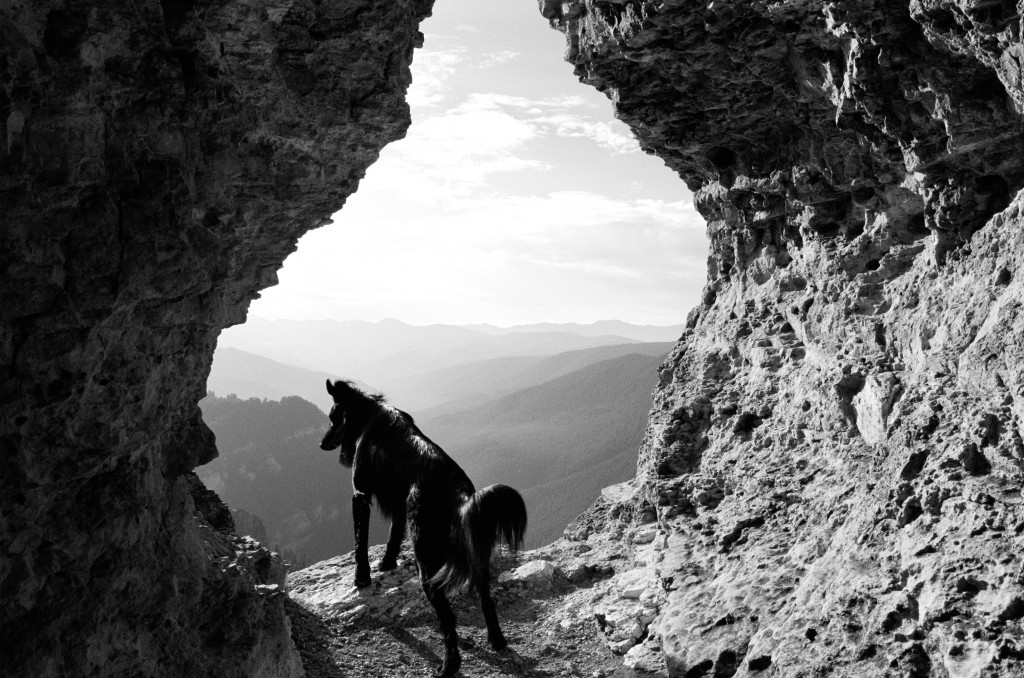Pick-up Dogs How Two Rescue Dogs Save the West from Being Won
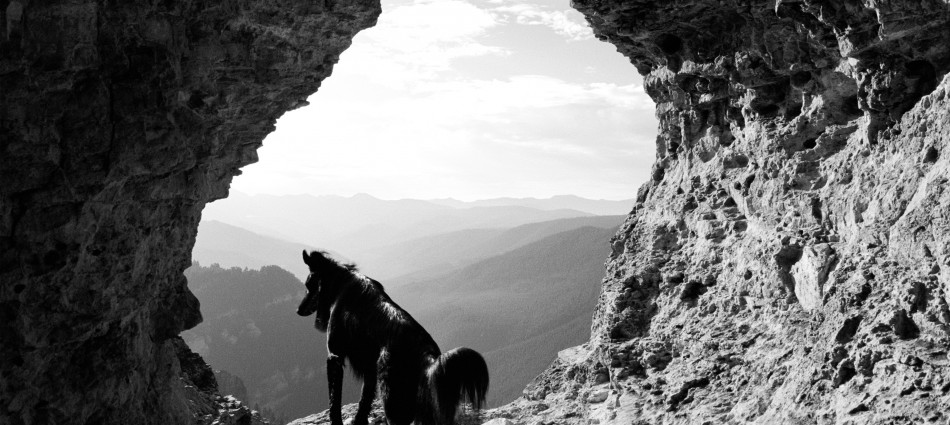
Secrets of Dog Photography
Many people have commented on the photography in Pick-Up Dogs, so I thought I’d give a couple of thoughts about photographing dogs; my dogs, at least. Bear in mind that I’m not a professional animal photographer. Although I do take pictures of others people’s dogs, especially when I travel (I have some beautiful pictures of dogs in Cuba that I’ll put up on the blog some day), I can take good pictures of my dogs because I know them well.
Knowing your subject well is my first main point about photographing animals. If you want to take good pictures of your dog, you have to know them well. Pay attention to their movements. Know their habits. For example: Lupe, my border collie mix, is a bundle of kinetic energy that hardly ever seems to stop moving. When we are out hiking, she runs up and down steep cliffs, fords streams, and hops over rocks at a pace that would be impossible for a human being to keep up with. Nevertheless, I know her movements well enough to time pictures to come when she’s pausing for breath. It’s hard to imagine that she does pause for breath, but I know that when she does, if I hold still enough she will pause and look pensive for a while. I take advantage of these moments by taking as many pictures as possible, exploring all possibilities of light.
Lupe in a quiet moment of repose between hours of terrorizing the countryside.
It would seem that Marcos, my Lab mix, would be a much easier photography subject than Lupe because he is more passive, mellow, and always follows close behind me when we hike. But just the opposite is the case. As soon as I bring out the camera, Marcos turns his head away. Awfully shy in these moments, he has the tendency to twist his body away from me just when I’m about to get the best picture of the day. I’ve found that lying down on the ground calms him down.
Marcos looking sweet.
In fact, lying down or kneeling really low is a point I find works well with all photography. Never underestimate the power of angles. I’m pretty tall at 6’2”, so I tend to stand rather imposing over most dogs. When I kneel down, I don’t intimidate them. Also, the angles of looking up into landscapes such as flowers, mushrooms, leaves, and other detritus look better when you look up at them rather than down. And just when you get bored of kneeling and looking up at objects, don’t forget to think about creative options for panoramic views, standing up on a stump or a cliff can provide a whole new perspective on a subject.
My next main concern would be equipment. Fortunately or unfortunately, photography is all about equipment. But that doesn’t mean that you have to go out and buy the world’s most expensive camera, because having overpriced equipment will not necessarily mean that you will take the world’s best pictures. In fact, I can think of many instances in which having an expensive camera is a detriment to your craft. I spend a ton of time on burly trails, crossing streams and laying in gravel, snow, and ice trying to take pictures. I could never spend much more than $500 on a camera because I do go through cameras relatively quickly. In my time, I’ve ruined cameras by sitting on them, falling into a pond with one on a midnight walk; I’ve had one get squeezed between my car seats in an awkward way and the lens bent just strangely enough to be ruined forever. I find that when I have expensive equipment, I don’t want to take it out when the conditions are slightly adverse. When you don’t bring the camera (because it’s expensive and fancy), you miss great opportunities. The most important piece of photography advice I’ve ever heard and you will ever read is that you have to have your camera near you all the time. It needs to live around your neck. You never know when you will get the right light or the right subject. The more time you spend playing with the camera, mastering its shutter speeds and playing with the F-stop, the more you will understand your camera and you might just get a lucky shot.
I now have a Canon G11, which I’m very happy with. It retails for around $500 and does just about everything that a fancy SRL will do. In fact, I’ve heard many professional photographers say that the G11 is their favorite “back-up” camera. What I like about the Canon G11 is that it is ugly. It looks like a simple point-and-shoot; it won’t get the attention that a fancy camera will and, because of that, I don’t have to worry nearly so much about it getting stolen. Also, because it’s not a fancy looking camera, I don’t intimidate people when I take pictures of them. The display screen swivels in such a way that I can look at it without it looking like I’m taking pictures of them. So, I can surreptitiously get great shots of them without their even realizing it. This trick also works with dogs. I can look Marcos straight in the eye and quickly set up a photo without him noticing.
This picture is the result of a lot of manipulation of the shutter speed to find optimal light.
Having said all this about non-fancy, non-technical cameras, my personal favorite picture that I’ve ever taken was one I took of Lupe that I took with a Minolta circa 1973 that I borrowed from my mom. This is a big, heavy camera (one of its many disadvantages), but when used correctly, gets better pictures than even the $3000 cameras that one can buy today. Which brings me to an important point. Whatever camera you get, however much money you spend on it, make sure that it has a device for changing the shutter speed. The best way to get unusual, creative pictures is by changing shutter speed appropriately and not using the built-in light device on the camera, which will get you average pictures, but not great, inspiring pictures. Constantly play with shutter speed. With digital photography, you don’t have to worry about the costs of developing film. I spend a fortune on developing film for the 1973 Minolta. Because it’s so old, it is very precarious to load the film properly, so I’ve gone through rolls of pictures, thinking I’m getting the best shots I’ve ever gotten of Marcos and Lupe in scenes totally impossible to recreate, and then I pop out the film and they’re all gone because I didn’t hook the film in correctly. We don’t have to worry about that now. So, when you’re out with your dog and you want to get a good picture of him, keep snapping. Keep twisting the shutter speed knob. Don’t stop. You should be filing through hundreds of pictures when you get home. For every beautiful picture I’ve taken, I’ve deleted probably 3000. That’s OK. That’s work I don’t mind.
Here I am setting up for taking the picture of Lupe on Storm Castle Mountain. Thank you to my wife Kirsten for getting a shot of me at work.
In the case of the picture of Lupe up on Storm Castle Mountain, I did all the maneuvering of the shutter speed well in advance of the picture. Because I know Lupe well, I knew eventually she would find her way to this lookout point over the valley. She was probably busy chasing chipmunks for a half hour before she made it to this point, but I kept waiting with the camera set up. I know her well enough that I knew eventually she would look out over the precipice. This moment in time only happened for 0.00015 seconds. I quickly snapped the picture and Lupe went barreling down the precipice to chase a butterfly or something. But I was ready. Because I’m tenacious with the camera and the setting up of everything, I got my shot. I’ve gotten other beautiful shots doing the same thing. Great photography comes with being willing to wait, willing to experiment with things like shutter speed, and most importantly, keeping on clicking away. All the time!
